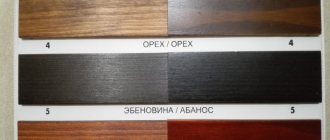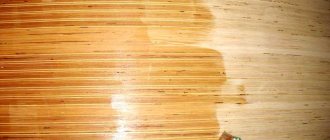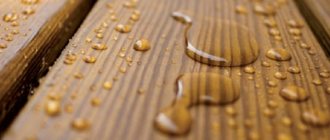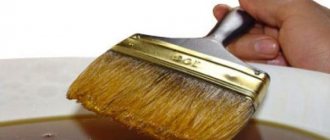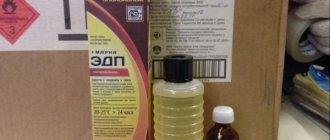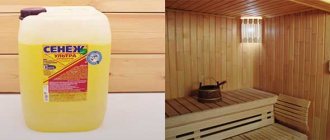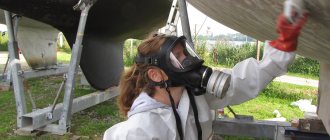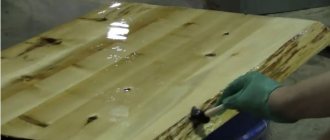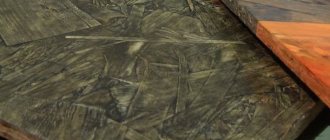Home/Articles/How to treat wood with copper sulfate?
Copper sulfate is a common remedy in the fight against mold, fungi and wood rot. Its popularity is caused, first of all, by its availability: you can buy it at any hardware store.
In this regard, many are interested in the question - how to properly treat wood with copper sulfate?
Most often, the solution is used in everyday life; it is used to treat trees and leaves in the garden at the dacha.
The main reason for wood rotting lies in its origin.
Wood is a natural material, capable of breathing, releasing juices, thereby increasing its humidity.
Even after treating the wood with paint, varnish or any other coating, it will not be possible to avoid the internal process of rotting. Therefore, very often they resort to treating wood with copper sulfate.
Features of tree structure
The location of the fibers in wood helps the material to absorb quite well a large amount of moisture coming from the outside. In this way it is somewhat reminiscent of the properties of a sponge.
- In addition, the trunks, when they have just been cut down, necessarily contain remaining vital juices.
- While performing useful functions during the growth and development of a tree, after cutting, they, on the contrary, contribute to the deterioration of the properties of tree species, accelerating the process of their decay from the inside.
If the outside of a wooden product can be protected by applying varnish or painting it, then such a thin surface film can provide protection exclusively for the outside.
But it is not capable of beneficially influencing processes of a biological nature in the internal part of a wooden structure.
A more significant effect can be obtained if you use biocidal-based antiseptic substances for these purposes. Copper sulfate, for example, or as it is also called copper sulfate, is quite often used in these cases in practice.
Protecting the interests of the gardener
Copper sand is known to every crop fighter as an inexpensive, and most importantly, effective way to control pests.
Take 20-30 grams of the substance and dilute it in 1 liter of H2O. The resulting solution is sprayed on trees and shrubs either in early spring, when there is no foliage yet and the buds have just begun to swell, or in late autumn, when they have already fallen.
It is not recommended to carry out such a procedure in summer.
There is a chance that you will get rid of not only pests. If you burn the greens, you will be left without a harvest.
Spotty necrosis and grape diseases are treated by spraying with a 5% vitriol solution in the fall.
For pests that have settled in the trunks, prepare an infernal mixture of 400 g of lime, 300 g of copper sulfate, 10 liters of water. The composition is sprayed or applied with a brush.
Irrigation with a solution of 100 g of vitriol and a liter of water will save you from moss, lichen, and wood rot.
Copper is a valuable microelement for plants. When there is not enough of it, the leaves turn yellow, young shoots die, and the flowers lose their brightness.
That’s why vitriol is so often used for foliar feeding of potatoes, cabbage, and tomatoes, diluting 5-10 grams of powder in a bucket of water.
This is an excellent fertilizer, a wonderful antiseptic, and inexpensive!
Use the instructions, follow the technology, recommendations, do not forget about personal safety equipment, and don’t even doubt that everything will work out.
What does an antiseptic do?
The use of copper sulfate is mainly associated with preventive measures that prevent:
- The formation of bacteria that cause signs of mold;
- The development and vital activity of various insects harmful to trees, not excluding wood borers;
- Processes that ultimately lead to the formation of foci of rotting;
- The emergence of the possibility of spontaneous combustion processes.
It cannot be argued that treatment with such an antiseptic substance is generally accepted as the most reliable method. However, it has an affordable price, and besides, it is not difficult to find. These two criteria make it so in demand and popular.
In addition, it cannot be denied that many more effective wood protection products contain additives of synthetic origin. And in many cases they can bring harm, rather than benefit, to the human body.
- A lot of research has been conducted specifically on the aspect of the impact on human health.
- According to reviews compiled by professionals, a fairly transparent picture emerges that, in addition to the fact that such treatment cannot cause harm to a person, the level of protection is also above average in terms of effectiveness.
- The possibility of rotting or the presence of a wormhole is practically eliminated.
In the presence of copper ions to improve the protective properties of wood species, destruction processes are blocked, as with conservation. This substance is absolutely safe for the health of people, as well as other inhabitants of the house, since it does not contain toxins with volatile properties.
An additional advantage is that after treatment the wood does not change its original natural shade at all.
Precautions when working with the drug
When processing a garden, a plot of land, or simply wood material, protective clothing and additional protective equipment in the form of a respirator, goggles and gloves are required. It is necessary to plan garden treatment on a day without expected rainfall and wind. If the solution gets on the mucous membrane, immediately rinse your mouth, face and hands with plenty of water. Even despite the minor danger that copper sulfate can cause to humans, the solution is still a chemical substance and can cause harm to the human body.
When working with vitriol, it is forbidden to eat or smoke, as the substance can get on the mucous membrane and cause intoxication of the body. The remaining solution should not be poured into storm drains, drains and ponds, and other places where there may be a concentration of people and animals. After completing work, you should thoroughly wash your hands, face and rinse your mouth.
Other types of antiseptic substances
Copper sulfate has a distinct crystalline form. It is easy to recognize by its characteristic bright blue color.
It is immediately worth noting that metal should not come into contact with it. It is never used on surfaces that contain metal fasteners.
If it is bred for processing, then they never use metal containers. When interacting with it, ferrous metal elements always experience severe corrosion.
If we talk about alternative possible methods, then they are antiseptic substances with an oil base, as well as bitumen. After exposure, the wood acquires good resistance to negative biological influences. However, they are not able to make a wooden structure decorative.
- The most famous oil antiseptic is creosote. This liquid smells extremely unpleasant. Has a slight yellow tint. It is produced from tar, which in turn is obtained from wood or coal.
- This substance is familiar to almost everyone, since wooden sleepers on the railway are impregnated exclusively with this composition. The advantage is that during processing, metal parts are not damaged.
- But carpentry and interior decoration are an exception, which can be explained by both the unpleasant smell and the unaesthetic appearance. In addition, creosote has been found to have toxic properties.
It contains harmful compounds phenol-formaldehyde. The volatility of the released toxins is very harmful to humans.
Causes of mold and mildew on walls
Mold can actively spread over the surface. If the necessary measures are not taken to solve the problem, the health of a person living in such conditions may worsen, even to the development of bronchial asthma. But the fungus does not begin to actively develop in all rooms. Favorable conditions are important for him. One of the common causes of mold development is a humid environment. In rooms with high air humidity, spores multiply more actively, penetrating deeper into the surface layers, reliably attaching themselves there.
A humid environment occurs due to constant temperature changes, regular freezing of the room, and wetness of various surfaces. The lack of a quality ventilation system only exacerbates the problem. Therefore, fungus can appear for the following reasons:
- Severe dampness in the room;
- Lack of good ventilation;
- Some parts of the room are not warm enough.
The apartment can be cozy and warm, but even if at least one corner gets wet or freezes, this is enough for mold to actively spread.
A common cause of mold development is a humid environment.
Specifics of using copper sulfate
Technologically, the following processing methods can be distinguished, in which copper sulfate solution is directly involved:
- The most simplified, but at the same time not giving a long-term effect, is considered superficial. A solution containing copper sulfate is applied to the wood. The most appropriate application method is selected. This could be a paint brush, a spray bottle, or a simple rag. It impregnates the wood no deeper than a couple of millimeters. That is, cracks that appear over time provide an opportunity for both pests and mold to develop;
- The second method is mainly used in cases where it will be necessary to bury wooden poles in the ground. They must first be kept in a prepared composition, which consists of twenty percent copper sulfate. The products are immersed in it for two or three days, and after that they are dried for almost a month;
- Trunks that have recently been cut down are processed using a deep penetration method. The fact is that the sap inside the tree continues to move, so this property can be used for the right purposes. An incision is made across. Then you need to insert the end of the tube into it. The second part of it is placed in a composition with copper sulfate. The container needs to be slightly raised above the level of the barrel. To ensure tightness from the outside, the hole is tarred after it is sealed with tow;
- Special equipment is used in the industrial processing process. The wood, dried in advance, must be placed in an autoclave, into which a forty-degree solution is then fed. In this case, tightness must be ensured.
After closing, a pressure level is added. This ensures the required penetration. After half an hour, the product is removed for subsequent drying.
Industrial processing
In production, wood is processed using special equipment.
First, the wood is dried, then autoclaved in a solution of copper sand at a temperature of 40 degrees above zero.
The pressure reaches up to 10 atmospheres, which allows the antiseptic to penetrate deep into the fibers. After 30 minutes, the wood is sent to dry.
It is impossible to repeat such a process at a professional level without the necessary industrial equipment.
Photo of copper sulfate to protect wood
What you need to remove mold using vitriol
Before you begin the troubleshooting process, you need to prepare everything you need in advance. This will allow you not to forget anything and approach the matter in a more organized manner.
To deal with mold, you need to prepare the following:
- Ready solution. It is enough to mix all the ingredients in one suitable container. To increase efficiency, it is recommended to add about 200 ml of vinegar per 10 liters of water to the finished composition;
- Tools with which the product will be applied to the surface. A spray bottle will do. It is the most convenient for such a process. But you can also use a brush or sponge;
- A spatula and a metal brush, allowing you to clean the affected areas;
- Means for protecting the body. In addition to clothing that covers all parts of the body, you need to equip yourself with gloves and a mask.
When these items are prepared, the process of eliminating the fungus problem begins.
Before you begin the troubleshooting process, you need to prepare everything you need in advance.
Tips for applying impregnation
Before starting work, it is advisable to more thoroughly prepare the surface on which the composition will be applied. Clean from dust and other contaminants and sand. Pre-treat existing cracks with white spirit and prime with alkyd primer.
Long-handled synthetic brushes or felt rollers are ideal for applying oil liquid. Excess must be removed with a soft, lint-free cloth. Repeat the manipulation in 1-2 steps.
Thick antiseptics are applied with a regular paint brush, sponge or soft rag, or a lint-free roller, while liquid ones are best applied with a spray gun.
When performing work on impregnating wood with an antiseptic outdoors, it is necessary to take into account external factors. It is better to choose dry, calm weather for applying the product.
Designate a special area for work. Prepare in advance all the tools, personal protective equipment and buy the missing items.
Internal wood impregnation work is permissible in well-ventilated areas.
When purchasing lumber, give preference to wood species that are most resistant to the destructive effects of external factors. These include: ash, pine, oak, Siberian larch
If desired, you can also use an old method to protect wood, which practically eliminates costs - roasting or boiling in a saline solution .
You can also impregnate wood using traditional methods - birch tar, flax oil, pine resin mixed with crushed coal and salt.
How long does the result last?
The duration of the result depends on many conditions. It is important not only to treat the surface, but also to organize everything in such a way as to prevent the fungus from re-developing. It is necessary to exclude high humidity, lack of ventilation and freezing, wetting of surfaces. Then the result from the process will last a long time. If favorable conditions for the spread of spores reappear, then such treatment will have to be repeated constantly. The result will not be long-term.
It is necessary to exclude high humidity, lack of ventilation and freezing, wetting of surfaces.
Preventive measures
In order for the treatment to give the desired result, preventive measures must be taken. This will reduce the likelihood of the fungus developing again and prolong the positive effect of vitriol.
There are a number of measures that will allow you to forget about the problem of mold spread. Among them:
- Regular ventilation of the room. This applies even to the winter period;
- Providing good ventilation;
- Avoiding hypothermia of walls;
- Make sure that the increase in humidity in the room does not last long;
- Monitoring the condition of plumbing. It must always be in good working order;
- Regular and careful maintenance of the water supply system;
- When carrying out repairs, it is necessary to use materials whose compositions are resistant to moisture. It is also recommended to use antiseptics;
- When arranging furniture, leave a small distance between objects and windy walls. Then the air will circulate without obstacles, freely;
- In rooms with significant levels of humidity, it is worth limiting the number of flowers to a minimum.
If the room has plastic windows, then you should take care of high-quality ventilation. Especially if the cladding is made of tiles or plastic panels.
When arranging furniture, leave a small distance between objects and windy walls.
How much does it cost and where can I buy copper sulfate?
Copper sulfate is not a scarce commodity. It can be purchased at any hardware store, as well as at specialized retail outlets for gardeners and gardeners.
The packaging design of copper sulfate may vary
Copper sulfate is an inexpensive antiseptic. When purchased in bags (25 kg), the price ranges from 139 to 193 rubles/kg. The cost of a small package at different retail outlets may vary:
- 50 g - from 25 to 32 rubles;
- 100 g - from 33 to 65 rubles;
- 200 g - from 75 to 106 rubles;
- 500 g - about 240 rub.
Mold damage to a wooden surface
Methods for preventing mold and mildew:
- You cannot use freshly cut wood - it must dry for about a year;
- it is necessary to waterproof the apartment and other rooms so that there is no “dew point”;
- carry out protective work against atmospheric humidity with specialized impregnations and paints and varnishes;
- To prevent condensation from forming, it is necessary to make a vapor barrier on the inner surface of the walls, and thermal insulation on the outside.
Removing mold from wood
